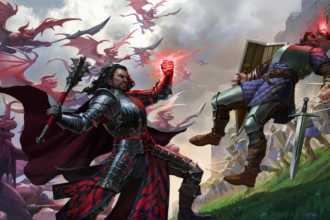The Sha’ir, Part One and Only

The Paladin, at last, is put to bed, and I can start on the Warlock. Except that there was no official warlock class in OD&D, 1e, or 2e, so I’ll be starting with its appearance in Complete Arcane, in 3.5e. Well, sort of… because 2e has this class, found in Al-Qadim, called the sha’ir. Sha’ir are based on the poets of pre-Islamic Arabia, who were believed to have mystical powers. In Al-Qadim, they derive their powers from their connection with a gen, and have unique means of summoning and interacting with janni and genies. In this way they are both a convenient single-article class, and a good lead-in to the warlock. This too is an arcane(ish) caster class dependent on a capricious entity.
Sha’ir are, to put it briefly, super weird. Of all things, it seems to me that they have the most in common with spellcasters in Earthdawn, without growing into insanely game-breaking engines of destruction. Or really ever getting all that great. Casting time is a problem, y’all. I’m getting ahead of myself; let’s break this down.
- Rather than learning, preparing, and casting spells like a wizard, a sha’ir has a gen that she sends to find spells for her. This has a base success chance of 50%, and takes an amount of time measured in rounds, turns (10 rounds, for those of you unfamiliar with early-edition timekeeping), or hours, depending on the rarity of the spell and the sha’ir’s level.
- This is both very good (you can cast more than one spell per day at first level? OMG NERF SHA’IR) and very nearly useless (at best, your spells have a delay of 1d6+1 rounds from the time you decide you want to cast them to the time you get to cast them, and they have a very high failure chance). It’s like spending several rounds Weaving a Thread in Earthdawn, except that the delay doesn’t take your action, never gets any better, and doesn’t avoid the very high failure chance.
- It’s nice that you can get clerical spells. Less nice that they levy an additional 30% penalty to the gen’s chance to retrieve it, and carry a chance of divine retribution equal to 10% per spell level (remembering that clerical spells cap out at 7th level in 2e).
- If the gen retrieves the spell successfully, you have three turns to decide to start casting it. This means that if you know a fight is coming, you can go ahead and send your gen out for pizza a spell you’ll definitely want to cast – maybe fireball – and as long as you start a fight within 30 minutes of its return, that one spell is practically free. You’re probably not casting a second spell in that fight.
- Anything that is useful outside of combat, including any long-duration buffs, are your go-to here. Don’t ever count on casting a spell during combat unless you had it ready to go before combat started. Since you’re a caster class and you will always be terrible at weapon-based combat, you should avoid combat absolutely whenever possible, and expect to be pretty bored when your party opts for combat.
- Fortunately, your gen can fight a little bit. A very little bit. You’re a wizard, it has half of your hit points, and you can do the math. If your gen dies, you are eight hundred kinds of screwed, and might die outright. Once you’ve had a few gen die or be severed from you (dispel magic does the trick), you might as well start a new character, because this sha’ir is well on the road to being just about unplayable. Once your gen is taking a minimum of 1d6+1 turns to find a spell for you, just burn this character sheet and start over.
- The briefer version of this is that every detail around gens is designed to make sure that gameplay is as hard and frustrating as possible. I would rewrite every word of this if I were to run a game with sha’ir. It is simply terrible.
- Recognizing Genie Work: At third level, sha’ir become a font of exposition for matters specifically relating to genies, and they can detect invisible, polymorphed, or disguised genies. Detecting genies or their labors takes the sha’ir’s action for the round and has a really pathetic chance of success until mid-to-high levels.
- I like the Font of Exposition side of this ability more than I like the Detect Genie Presence side, because the percent success chance means that you’re completely wasting actions in a lot of combat situations. The Font of Exposition ability should be rewritten to automatically succeed, because failure is so uninteresting, but I don’t blame a 2e supplement for being designed as if it were the early ‘90s.
- Other games – Leverage and Feng Shui do this, I think? – set each skill group up to make a character with that skill useful as a font of exposition for the relevant ability. This is territory that D&D can easily emulate, but doesn’t get included in collections of Best Practices DMing.
- Calling Upon the Jann: At fifth level, the sha’ir might be able to summon a jann. The primary function here is to get the jann to lead you out of the desert when you are hopelessly lost, at which point it also feeds you. It might also fight for you if you are attacked. Everything else about this ability is limitations, failure chances, and costs. Also, like the earlier sha’ir abilities, this has a percentage success chance based on the sha’ir’s level.
- This percentage-success thing has got to go. It’s written to be some completely different tabletop game. 2e is all about the one-off subsystem rather than unified mechanics, but this feels like it should have been published by Chaosium rather than TSR. (That’s not a slam on Chaosium – I’m just talking about their d100 resolution system.)
- Elemental Protection is the first ability they receive that doesn’t include a percent chance to fail. It’s a nice survivability improvement against many kinds of spellcasters and elemental creatures. It also allows temporary survival (one turn per level) in elemental planes, which would be a lot more useful if it could be extended to allies.
- Calling a Genie is another percentage-based ability, and whether you succeed or fail, you can use it only once per week. If this is successful, the sha’ir can bargain for a particular service, which is one of the better ways to become a serious pet class in 2e, or a wish, which explicitly only works if the genie thinks it has outsmarted you.
- Alternately, you might be able to bind the genie long-term. Importantly, this book was released in the same year as the movie that sums all of this up for you. If you successfully persuade or compel the genie into a compact, this class is suddenly kind of amazing. You have a professional ass-kicker what grants wishes (assuming that not granting wishes wasn’t a term of your contract).
- At the same level that other character classes attract followers and build strongholds, you (can) get a genie. Life is pretty good here… and honestly, 2e’s domain-level play should have made it more explicit that wizards should have genies and devils and fey at levels 9 and above.
- Creating a Genie Prison is… wait, what? You have a whole class ability for this? I mean, cool, but this seems super specific! It does explain why the rest of the text focuses on potential conflict between genies and sha’ir, that’s for sure. At 13th level, a failed saving throw makes any genie do pretty much whatever you want, though as far as wishes go, they’re limited to three per genie.
- Yeah, okay, the class has come around the bend from “I don’t see how you survive or have fun” (which is true of all low-level wizards) to “uh… overpowered much?” And all you have to do is survive to 13th level! Good luck, friend.
- Also, you can bind up to five genies at a time in genie prisons. Yikes. This is a radical increase in your combat power, since you can just compel them to be your indentured servant for up to 1,001 days.
- Elemental Travel comes along at 15th level, right about the same time that druids are thinking about wandering the Inner Planes. Not that there are any druids native to Zakhara… it’s more like sha’ir are the druids of Zakhara. Anyway, this ability only provides a means of travel for the sha’ir and allies (or enemies, who receive a saving throw).
- Finally, at 17th level, they gain Receiving an Audience, which (if we’re honest) is contact other plane with a huge amount of flavor text, a casting time of 1d10 days, a once-per-month casting limit, and a potential death sentence if you’ve killed very many genies over the course of your career. It seems really cool, but the text emphasizes reasons not to use it.
- On the other hand, one can interpret the text as indicating that you don’t have the scaling chance of insanity and death that comes with contact other plane, so that helps rather a lot.
So what we have here is a class that starts off extremely unreliable, but with no way to “run out” of spells in a day. This is a terrible mechanic, but let’s be real, you’re just sticking it out for the high-level stuff. As you go along, you get some modestly relevant abilities. Suddenly, boom, 9th level, you’re unbelievably powerful, and it only gets crazier from there. The difficulty of negotiating with gen, jann, genies, and noble genies really drives home the similarity to 5e warlocks (much less so for 3.5e and 4e warlocks, but those editions gave very little attention to relationships derived from character classes.
The theme of the class as an artist-wizard who has a love-hate relationship with genies as patrons and servants is pretty awesome, and follows legendary sha’ir pretty well. With a cleaner set of mechanics, this could be pretty great. So… does the Complete Sha’ir’s Handbook have anything to offer?
Yes, Virginia, There Is a Complete Sha’ir’s Handbook
Because why wouldn’t there be?
It is not here to make life better for sha’ir, let me tell you that.
It is here to add more roleplaying restrictions and burdens to the interactions between sha’ir and gen. In theory, these are details to enrich the experience. In practice, it feels in every way like discouragement: more ways to offend the gen and lose your class abilities.
The book introduces new rituals to power up your gen and improve their combat survivability. These rituals are punishingly difficult – the text calls out that they are basically impossible and should not be attempted without casting all of the buffs that improve your ritual casting, because seriously, you’re not going to succeed and you might die of dehydration. Basically, it’s a case of requiring too many consecutive successful rolls in order to actually succeed; you can fail a little bit, but failure penalties stack up to “impossible” in a real hurry. These rituals have all of the problems of 4e skill challenges with none of the good parts. On the other hand, if you survive, you can give your gen some crazy-awesome abilities and make them into useful team members, rather than just the obvious, vulnerable focus that all of your spellcasting depends upon.
There are new kits in this book as well – it’s 2e, what did you expect? – but they are more like independent spellcasting classes than kits. Well, from a 5e perspective, they’re really new subclasses of wizard, or possibly other arcane caster classes.
Despite its name, this book is mostly not about sha’ir. It is mostly about arcane casters in Al-Qadim as a whole, and about adding restrictions and nitpicky details. I think it does more to teach DMs to be insufferable jerks to their players than anything else. Learn from this book: learn what not to do.
The good side – there is one, however slim – is that it gives a sense of what a sha’ir’s life is like outside of combat and high-conflict situations, such as adventures. Sha’ir get to interface with a part of Zakhara that is unknowable and terrifying for everyone else, which is another thing that makes them similar to warlocks.
If you’re running 5e, you could absolutely offer Genies as homebrewed warlock patrons, and maybe spell-summoning as a homebrewed pact. Their spell list should possibly be tweaked for theme. If there are going to be genasi in your world, do yourself a favor on the story side and make genies a central story element. Genasi as distant offspring of genies, just as tieflings are distant offspring of fiends, can only improve their racial story.
Next week: the Warlock!
Post script: I realize that there was a sha’ir released for 3.x in some Dragon Magazine article. I… don’t think I care enough to hunt it down and write about it. Disagree? Convince me in the comments box.
Post-Post Script: To my endless chagrin, my readers have triumphed over my better judgment reluctance, and there will be a surprise Part Two, in which I expect to cover the 3.x and 4e Sha’ir. In other news, I learned today that there is a 4e Sha’ir. Yeah, I was as surprised as you!
Thank you to all of my readers, for taking enough of an interest in these humble offerings to argue with me.



